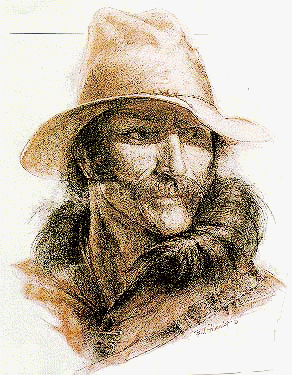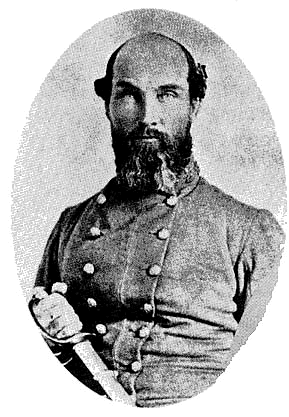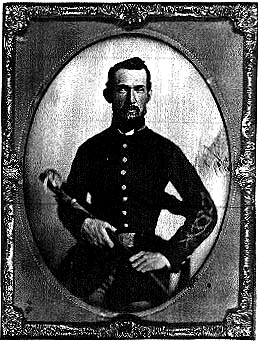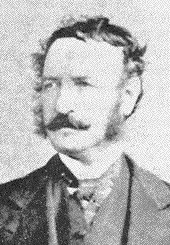COLONEL SHEROD HUNTER
A Biography of Our Camp's Namesake
by Robert Perkins

Colonel Sherod Hunter
Sherod Hunter was born 5 March 1834 in Lincoln County, Tennessee, son of Sherrod Hunter and his second wife, Elizabeth Dickson. He was orphaned in August of 1840, when his parents both succumbed to an epidemic, perhaps cholera, and during his childhood lived in the households of various relations.1 He was married to Miss Mary Elizabeth Goodrich in Fayetteville, Lincoln County, Tennessee, on 15 November 1855. Mary was the daughter of Hunterís business partner, Thomas Goodrich, with whom he operated the firm of Goodrich and Hunter, a successful grocery business. On 3 March 1857 Sherod and Mary Hunter became the proud parents of a baby boy, named Thomas Sherod Hunter (after the child's father and grandfather). However, tragedy would soon devastate the family. Mary, weakened by the hard childbirth, died ten days later, on Friday, 13 March, 1857.2 His young son soon followed, passing on 6 July 1857.3 Struck by this double tragedy, Hunter found it impossible to continue in Lincoln County. Ten days after the child was buried, Sherod sold his interest in the firm of Goodrich and Hunter to his father-in-law. He left Tennessee shortly afterward.4
It is uncertain where Hunter went when he left Tennessee. Historian Boyd Finch has postulated that Sherod Hunter moved to Leavenworth, Kansas, where he may have worked as a freighter. This supposition is based on some letters written from "Leavenworth City, Kansas Territory" to the Fayetteville, Tennessee, newspaper, the OBSERVER. These letters were signed only with the initial "H," and so could have been written by Hunter.5 But there is no way to know this for sure, and there is no other evidence linking Hunter to Kansas. We do know that he arrived in New Mexico Territory sometime between 1857 and 1859 (In his memoirs, James Henry Tevis, who later served with Hunter in the Confederate Army, states that Hunter was in New Mexico as early as July-September 18576; but historian Finch, based on the fact that Hunter apparently didn"t leave Lincoln County until late July 1857, as well as on the "H" letters cited above, gives the later date), when he settled in Mesilla, Dona Ana County, New Mexico. About 1858 or 1859 he settled on a plot of land beside the Mimbres River, about 25 miles north of the present-day town of Deming, New Mexico, and near to a now-abandoned town called Mowry City. He was a farmer by trade, and is listed as such in the 1860 Census of Dona Ana County, New Mexico. His real estate was valued at $200 and his personal property at $600 in said Census. He does not seem to have owned any slaves.7

Governor John R. Baylor
Confederate Territory of Arizona
Sherod Hunter readily adopted the profession of soldier when the Confederate Governor of Arizona, John Robert Baylor, called for volunteers to defend the newly created Confederate Territory from the triple threat of Yankee invaders, Apache marauders, and Mexican Banditos. Enlisting as a private in Captain George Frazer's Company of Arizona Rangers (a militia company formed in May 1861 at Mesilla, New Mexico), Hunter was promoted on August 1, 1861 (probably by vote of his men) to the post of First Lieutenant in that company.8
Hunter seems to have been highly regarded by his men and by his superiors. When Governor Baylor decided to raise a Regiment of Arizona Rangers for frontier defense, he commissioned Sherod Hunter as a Captain and charged him with the recruitment of the first company. The MESILLA TIMES of January 8, 1862 had the following to say of this: "We are pleased to hear that Capt. Hunter is being very successful in his efforts towards organizing his Company...We do not know of a single officer under whom we would rather serve, nor one who has more compleetly (sic) the confidence and respect of his men, than he has of those of Capt. Frazer's Co., in which he was recently First Lieutenant."9

Tucson, Arizona in 1864
On February 10, 1862, Captain Hunter and Company A, Baylor's Regiment of Arizona Rangers were ordered to proceed to Tucson, Arizona, there to establish an advanced military post for observation of Union forces known to be gathering in California, and to pacify the surrounding area, which was under threat of attack by the dreaded Apache Indians.10 These orders marked the beginning of Captain Hunter's Arizona Campaign, which was to last until May 14, 1862. Arriving in Tucson on 27 February 1862, Hunter conducted a brilliant hit-and-run campaign in which his tiny Confederate force (consisting of less than 100 men) liberated what is now the state of Arizona from the rule of the United States, carried the Confederate flag to within 80 miles of the Colorado River (the farthest west penetration of the Confederate army), captured or destroyed foodstuffs and hay stored for the use of a 2,000-man Union army from California, thus delaying the advance of said army by more than a month, and fought and won the westernmost skirmish (Stanwix Station, March 30, 1862) and battle (Picacho Pass, April 15, 1862) of the War Between the States. During this campaign they inflicted losses of 3 killed, 4 wounded, and ten captured on the Californians, for a loss of only three men captured (by the Yankees at Picacho Pass) and one dead (not by enemy action...Private Benjamin Mays died ofpleurisy at San Simon on 25 February 1862).11 They also fought 2 engagements against the Apaches in which they lost four men killed (at Dragoon Springs on May 5, 1862) while in return slaying five of their enemies (on May 9, also near Dragoon Springs).12 They were finally forced to evacuate Tucson on May 14, 1862, arriving back at Mesilla on May 27, 1862.13 When the Confederate Army of New Mexico evacuated the Mesilla region and went back to Texas, Captain Hunter and Company A (which had, in June 1862, been amalgamated with other Arizona cavalry companies to form Lt. Col. Philemon T. Herbert's Battalion of Arizona Cavalry) went with them.14
Herbert's Battalion of Arizona Cavalry, including Captain Hunter and the Arizona Rangers, arrived in San Antonio in late July of 1862.15 Shortly thereafter, Captain Hunter resigned his commission as Captain of the Arizona Rangers, and went on extended furlough (from August to October of 1862).16

Colonel George Wythe Baylor
Second Arizona Cavalry Regiment
The resignation of his commission as Captain of the Arizona Rangers marked the beginning of a glorious new chapter in Sherod Hunterís career as a Confederate officer. On October 3, 1862, upon returning from his furlough, Hunter was promoted to the rank of Major, third in command of Colonel George Wythe Baylor's Regiment of Texas Cavalry. George Wythe Baylor was the younger brother of the former Confederate Governor of Arizona, John R. Baylor, and the regiment had been raised at Columbus, Texas as part of John R. Baylorís newly-forming Arizona Brigade. Thus Baylor's Regiment became known as the Second Cavalry Regiment, Arizona Brigade...a title that was often shortened to "Second Texas-Arizona Cavalry."17

Battle Flag of Major General Richard Taylor's Army in Louisiana
Sherod Hunter and the Second Arizona would have served under a flag
such as this during the Red River and Bayou Teche Campaigns
Sherod Hunter and the Second Texas-Arizona Cavalry played a prominent part in the campaigns against the army of Union General Nathaniel P. Banks in Louisiana in 1863 (the Bayou Teche Campaign) and 1864 (the Red River Campaign).18 Hunter's most famous achievement during this period was the capture of Brashear City, Louisiana. The Federal Army had established a major supply depot at that site, which was located on the east shore of Berwick Bay (a broad portion of the Atchafalaya River which flows into the Gulf of Mexico). The Confederates desperately needed those supplies, and Major General Richard Taylor, commanding Confederate forces in the region, ordered their capture. Major Sherod Hunter of the Second Arizona Cavalry was put in command of the assault force.19
On the night of June 22, 1864, Major Hunter led a motley force of 250 Confederate cavalrymen (three companies from his own Second Arizona Cavalry, volunteers from several other Texas Cavalry units, and a contingent from the Second Louisiana Cavalry) aboard a strange flotilla of flatboats, skiffs, rowboats, dugout canoes, even sugar coolers...in short, anything that would float. Hunter and his "mosquito fleet" slipped silently down the Bayou Teche to the Atchafalaya River, thence up said River to Brashear City (a distance of about 12 miles, all of which had to be traversed by rowing, as the boats had no sails). At daybreak on June 23, 1863, Hunter's force disembarked from their strange fleet, then marched a further four miles, single file, through a swamp of mud, water, and tall palmetto to reach Brashear City.
Upon emerging from the swamp, Hunter's men were greeted by the sight of row after row of white tents, pitched thickly for the space of half a mile, as well as two imposing earthwork forts. Many of the Confederates briefly lost heart and retreated back into the swamp, thinking that a large army lay before them. Major Hunter rallied them, saying "We may all be shot...Not one of us may get back to the brigade; but gentlemen, we'd better just fall down in our tracks than go back disgraced, and have old Tom Green tell us so!" Upon hearing these stirring words, which were likely sprinkled with some profane language that has been expurgated by the chronicler of this scene), Hunter's men formed up and moved ahead toward Brashear City.
As Hunter and his men emerged from the woods, Confederate artillery stationed on the shores of Berwick Bay across from Brashear City (including the four guns of the Valverde Battery, captured by the Confederate Army of New Mexico at the Battle of Valverde in 1862) opened fire, drawing most of the Union garrison to the shores of the bay. Hunter led his men in a bayonet charge that took the enemy completely by surprise. The earthwork forts guarding Brashear City were quickly captured, and then the Confederates were in the town itself. Most of the Union garrison was too stunned by this sudden onslaught to put up a fight, but the Confederates did find a few pockets of resistance that cost them 3 killed and 18 wounded. But these were soon crushed, and by 11:00 a.m. all Union resistance was at an end. Hunter and his 250 men were the proud possessors of Brashear City, 1,300 Union prisoners, 11 heavy siege guns, 2,500 stands of Enfield and Burnside rifles, immense quantities of quartermaster, commissary and odnance stores, as well as 2,000 negroes and between 200 and 300 wagons and tents. The overall value of the captured supplies was more than $2,000,000, and Richard Taylor's Confederate Army was to be well supplied by them right through the Red River Campaign of 1864.
Although the capture of Brashear City was certainly the high point of Sherod Hunter's career as a Confederate officer, it was not the end. Indeed, the "gallant Major Hunter" figures prominently in the correspondence of his commanding officers throughout the remainder of the Bayou Teche campaign in 1863, and the later Red River campaign of 1864.

Major General John Bankhead Magruder
Military Department of Texas, New Mexico and Arizona
As a result of his experiences in Louisiana and in Arizona, and the high regard by which he was held by his superiors, Hunter became the center of a scheme to attempt the recapture of Arizona for the Confederacy, or at least to raise manpower for the Confederate armies from among the Southerners known to reside there. On June 6, 1864, Major General John B. Magruder, commanding the Military Department of Texas, New Mexico, and Arizona, proposed to "send Major Hunter to Arizona to raise a regiment...Major Hunter is lately from Baylor's Regiment, brings highest recommendations from his superior officers and has commanded successfuly (sic) in Arizona in the early part of the war as well as in Louisiana."20 Hunter established himself at Fort Duncan, a post at Eagle Pass (a Mexican-border town in far-west Texas), and was able to raise a battalion of approximately 300 men by September 1864.21 Shortly afterward Hunter left for Richmond, there to solicit support for the Arizona venture. He was rewarded, on January 25, 1865, with orders from the Confederate War Department in Richmond officially detaching Hunter from the Second Texas-Arizona Cavalry and authorizing him to raise a regiment for service in Arizona and New Mexico. Hunter's orders directed that he was to "return muster rolls and certificates of the election of the officers, with other proper information to this Office, for its action," and stated that he was authorized to select any "persons within our lines" to help in raising the regiment, so long as they were not already in the army nor liable for service as conscripts.22
One intriguing question arising out of these orders remains unanswered...was Sherod Hunter promoted to the rank of Colonel, or did he finish the war as a Major? Hunter seems to have taken the title of "Colonel" after this time, and this may have been confirmed by the Army of the Transmississippi Headquarters, although no extant document has been found confirming such an appointment. However it was standard practice to raise to the rank of Colonel one who had been appointed to the command of a Regiment, and we do know that he was addressed as "Colonel" by subordinates in official reports. Many documents were lost in the turmoil of the war's last days, and it is not unlikely that the order confirming the promotion of Sherod Hunter to Colonel's rank was among them.23
Little is known of Hunterís activities after his return to Fort Duncan in February 1865. It is likely that Hunter went to Mexico to recruit for his new Regiment during this time. Hundreds of secessionists who were able to escape from Union-controlled Territory (especially California, but also from Arizona, Colorado, and even as far away as Washington and Oregon Territories) took ship to the Mexican ports of Mazatlan and Guaymas, formed so-called "mining parties," and made the dangerous overland march across Sonora and Chihuahua to Texas to join the Confederate army.24 A Union intelligence report addressed to Hunterís old nemesis, Brigadier General James H. Carleton of the California Column, had earlier (November 1864) placed Hunter in Mexico, and even in California, recruiting these men. Hunter would likely have gone back to Mexico in search of recruits for his new regiment.25

What finally became of Colonel Sherod Hunter, C.S.A.? Again, little firm evidence exists to answer this question. He was probably still in Mexico, recruiting for his new regiment, when news arrived of the surrender of the Confederate armies and the end of the war. He definitely was in Mexico shortly after the end of the war...in February 1866 his presence in Mexico City was noted in the MEXICAN TIMES, a newspaper edited by the former Confederate Governor Louisiana, Henry Watkins Allen. The article stated that he was "just in from Monterrey."26 It is known that he joined the movement to form a Confederate colony at Cordova, near Vera Cruz, based on a June 1866 report in the FAYETTEVILLE (Tennessee) OBSERVER, the local newspaper in Hunterís native Lincoln County. On May 11, 1866 Sherod Hunter left Mexico and returned to his former home in Lincoln County, Tennessee, arriving there by June 7 (his return is chronicled in the FAYETTEVILLE OBSERVER report cited earlier), but he did not stay.27 And it is there that his trail ends. Nothing is known for certain of his later life and death. He may have returned to Mexico, and indeed, an unsigned letter from "an old friend who was formerly a resident of this county, now a resident of Mexico," likely to have been written by Hunter, appeared in a July 1868 edition of the FAYETTEVILLE OBSERVER.28 If this letter was written by Hunter, it is the last record Hunter left of himself. He is not found in the 1870 or later Censuses of any State or Territory of the United States, and thus an unmarked grave somewhere in Mexico probably holds the mortal remains of Colonel Sherod Hunter, C.S.A.
NOTES
1L. Boyd Finch, CONFEDERATE PATHWAY TO THE PACIFIC: MAJOR SHEROD HUNTER AND ARIZONA TERRITORY, C.S.A. . Tucson, Arizona: Arizona Historical Society, 1996, pp 6-8. Hereafter cited as Finch, PATHWAY.
2Finch, PATHWAY, pp 14-15.
3
Finch, PATHWAY, p. 19.4
Finch, PATHWAY, pp. 19-20.5
Finch, PATHWAY, pp 20-21.6
James Henry Tevis, ARIZONA IN THE Ď50íS. Albuquerque, New Mexico: University of New Mexico Press, 1954, p 18.7
Charles Leland Sonnichsen, TUCSON: THE LIFE AND TIMES OF AN AMERICAN CITY. Norman, Oklahoma: University of Oklahoma Press, 1982, p. 62; L. Boyd Finch, "Sherod Hunter and the Confederates in Arizona," JOURNAL OF ARIZONA HISTORY, Spring 1969, pp 141-142, hereafter cited as Finch, "Hunter.".8
Martin Hardwick Hall, THE CONFEDERATE ARMY OF NEW MEXICO. Austin, Texas: Presidio Press, 1978, p. 361, hereafter cited as Hall; Finch, "Hunter," p. 153.9
Hall, p. 361.10
The February 10 order dispatching Hunter to Tucson is found in the Sherod Hunter "Jacket" in the National Archives, "Collections of Private Military Papers of Officers of the Confederate States Army.".Another order, dated February 9, 1862 and reprinted in Finch, "Hunter," pp 202-203, gives instructions for Hunterís administration of Tucson, establishing friendly relations with the Pima and Papago Indians and with the Mexican state of Sonora, and keeping watch on the activities of Union forces known to be gathering in California.11
Sherod Hunter, report to John R. Baylor, April 5, 1862, reprinted in Calvin P. Horn and William S. Wallace, CONFEDERATE VICTORIES IN THE SOUTHWEST, pp. 200-201; Sherod Hunter, report to John R. Baylor, April 18, 1862, reprinted in Finch, "Hunter," pp203-204; Captain William P. Calloway, 1st California Infantry, report to Major Edwin A. Rigg, April 18,1862, reprinted in Finch, "Hunter," pp 205-206.12
Finch, PATHWAY, pp 152-153.13
Hall, p. 363; Finch, PATHWAY, p. 153.14
Finch, PATHWAY, p. 164, 166-167.15
Hall, p. 363.16
National Archives, Compiled Military Service Record of Major Sherod Hunter, Second Texas-Arizona Cavalry.17
National Archives, Compiled Military Service Record of Major Sherod Hunter, Second Texas-Arizona Cavalry; Stewart Sifakis, COMPENDIUM OF THE CONFEDERATE ARMY--TEXAS, New York: Facts of File, 1995, p. 44, hereafter cited as Sifakis.18
Sifakis, p. 44, gives an extensive list of the Regimentís engagements during the said campaign.19
A detailed account of Sherod Hunterís capture of Brashear City is found in L. Boyd Finch, "Surprise at Brashear City: Sherod Hunterís Sugar Cooler Cavalry," LOUISIANA HISTORY, Fall 1984, pp 403-435. All facts relating to this episode are from this source.20
Finch, "Hunter," p. 200.21
L. Boyd Finch, "Arizona in Exile: Confederate Schemes to Recapture the Far Southwest," JOURNAL OF ARIZONA HISTORY, Spring 1992, pp 76-77, hereafter cited as Finch, "Arizona.".22
Finch, "Hunter," pp 200-201.23
Finch, "Arizona," p. 76, notes that Captain Henry Kennedy, formerly of the Third Texas-Arizona Cavalry Regiment, who had been assigned to assist Hunter with recruiting for the proposed regiment, addressed Hunter as "Colonel" in official reports.24
Finch, "Arizona," p. 74.25
Finch, "Hunter," 201; Finch, PATHWAY, p. 221.26
Finch, PATHWAY, p. 229.27
Finch, PATHWAY, p. 23028
Finch, PATHWAY,p. 233.![]()
Some of the clipart on this page is used courtesy of
and
The music file of "The Battle Cry of Freedom" was composed and is copyrighted by Barry Taylor. Great, ain't it? For more great music files like this one, visit THE CONTEMPLATOR'S FOLK MUSIC SITE.
![]()
 BACK
TO THE ARIZONA CONFEDERATES PAGE
BACK
TO THE ARIZONA CONFEDERATES PAGE
Copyright 2000 by the Colonel Sherod Hunter Camp 1525, Sons of Confederate Veterans, Phoenix, Arizona. All rights reserved. Last updated on 18 February 2003.


 CHARGE
AHEAD TO THE NEXT PAGE
CHARGE
AHEAD TO THE NEXT PAGE